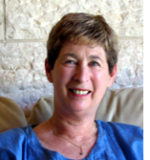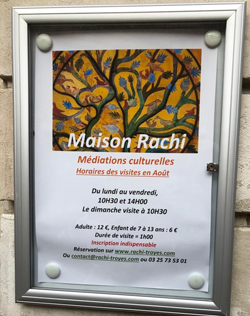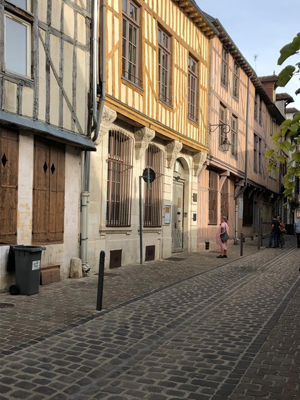
 TROYES, France — Several years ago I was told that I really ought to visit the French town of Troyes (pronounced ‘Trois,’ like the number three in French), since it is a charming medieval town. It is also the birthplace of Rashi, the great twelfth century commentator on the Bible and the Talmud, who is known by the acronym of his full name, Rabbi Shlomo Yitzchaki.
TROYES, France — Several years ago I was told that I really ought to visit the French town of Troyes (pronounced ‘Trois,’ like the number three in French), since it is a charming medieval town. It is also the birthplace of Rashi, the great twelfth century commentator on the Bible and the Talmud, who is known by the acronym of his full name, Rabbi Shlomo Yitzchaki.
Finally, after many years of spending our summers in France, we finally managed to make the trip to the east, going towards the border with Switzerland, to the Champagne region, where Rashi lived (1040-1105). Having read Maggi Anton’s trilogy about Rashi’s daughters (he had no sons), I was especially curious to see what the place was like.
I was not disappointed. The old part of Troyes is indeed charming, with its half-timbered, or even full-timbered, old houses, some of which seem to be about to collapse, while others are in a relatively good state. Many buildings date back to the twelfth century, and some are still in use as private residences, restaurants, or cafes. Some contain institutions of various kinds, such as the Rashi (spelled Rachi in French) Institute and Cultural Centre, or the Museum of Ancient Tools and Musical Instruments. Everything is within walking distance, and the open, tree-shaded squares are full of restaurants and cafes, a veritable tourist’s paradise.

The town is a mixture of ancient and modern buildings, with stores such as H&M and Etam in the street adjacent to the narrow ancient roads where Rashi and his contemporaries once walked. I didn’t see a McDonald’s, but that doesn’t mean that there wasn’t one there somewhere. The town has expanded into the surrounding countryside, so that the vineyards that allegedly were once tended by Rashi and other local vintners have been supplanted by commercial and industrial buildings. Nonetheless, the drive there took us through beautiful French countryside, which may well have remained unchanged since Rashi’s time.
In addition to the building that commemorates Rashi, Troyes has other sites of interest. The town has several ancient churches, and its enormous cathedral, which also dates from the twelfth century, is one of the grandest I have ever seen. Its Norman architecture is beautifully preserved, and its stained-glass windows are on a par with any to be found in Chartres or elsewhere. Outside the cathedral is a plaque that was installed there in 1929 to mark the five hundred-year anniversary of the visit there by Joan of Arc. The plaque declares that in 1429 Joan arrived in the town, accompanying Charles VII en route to Reims, and that the townspeople spontaneously acknowledged him as their legitimate king in that cathedral.
In addition to a plaque in French and English explaining who Rashi was and what he did, a black plaque is affixed to the wall outside Maison Rachi, where Rashi’s bouse once stood, stating in gold letters (in French): “The French Republic pays its respects to the victims of racist and anti-Semitic persecutions, and of the crimes against humanity committed under the de facto authority of the so-called ‘Government of the French State’ (1940-19944). We will never forget.”
I had wanted to conclude our visit by drinking a glass of champagne as I toasted Rashi, but somehow it didn’t work out.
*
Shefer-Vanson is an author and freelance writer based in Mevasseret Zion, Israel